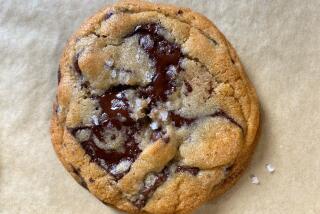THE COOKIE CLINIC
- Share via
When baking cookies on the bottom rack of your oven, stack two baking sheets together. The extra insulation will prevent the bottom batch of cookies from burning. You can also do this for the top rack of cookies--if you are held up for a couple of minutes, the doubled sheets give you a little more leeway before cookie bottoms burn. Doubled-up sheets also allow the bottoms to stay just golden while the tops of the cookies finish browning.
* To make softer and/or chewier cookies, substitute 1 to 3 tablespoons of liquid sweetener (such as honey, corn syrup or molasses) for an equal measure of sugar. Too much, however, will alter the liquid balance in the recipe.
* Reducing the baking soda or baking powder slightly also makes chewier, softer cookies. Leaveners give cookies a more cakey texture. Reducing the leavening produces a lower, flatter cookie that’s chewier.
* Regular chocolate chips retain their shape when baked. Chopped-up chocolate bars (which have not been tempered for baking) tend to melt and ooze, as well as lose their shape when baked.
* Have all your ingredients at room temperature. They’ll mix better.
* Chill very soft doughs briefly for easier handling. Doughs that are too soft may spread too quickly or thinly.
* On the other hand, if you want a thin cookie that spreads a lot, room temperature dough is the way to go. A greased cookie sheet (or greased parchment paper) further encourages spreading.
* Unbleached all-purpose flour is recommended for the best spread on cookies. Bleached or chlorinated flours reduce spread.
* Using parchment paper gives cookies with an even rolled edge that is also more professional looking. A lightly greased baking sheet results in cookies with thinner, more uneven edges.
* For slightly raised or puffier cookies, bake in the upper third of the oven. For thinner, crisper cookies, bake in the lower third.
* Size matters. Large cookies taste different. Make oversized versions of these recipes for entirely different results. Kids find this especially appealing too.
* You can easily double or even quadruple cookie doughs and freeze the dough for bake-a-thons up to six months later. Freeze the dough in large, flattened disks or, if you’re ambitious, in individual drops (use a miniature ice-cream scooper). Wrap the disks in wax paper or parchment paper. For individual drops, freeze the drops on a baking sheet before placing them in a plastic bag and storing in the freezer.
* Most cookies retain their flavors better if stored in a cookie jar or tin in the refrigerator.
More to Read
Eat your way across L.A.
Get our weekly Tasting Notes newsletter for reviews, news and more.
You may occasionally receive promotional content from the Los Angeles Times.










